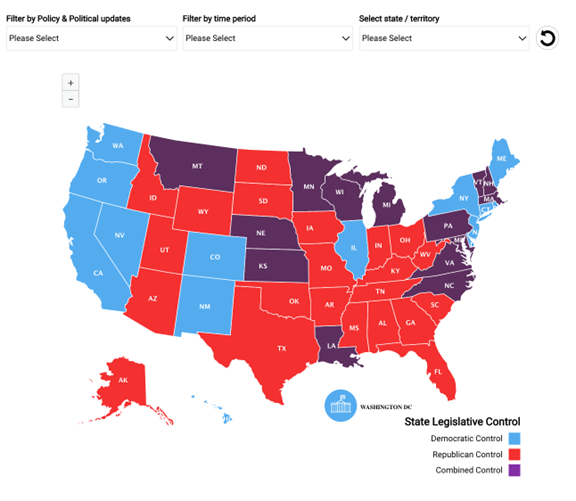The State of the States is a digital platform for US policymakers, legislators, academics, journalists, students, and more. Having begun as an overview of politics and policy at the local and state levels in the United States, the platform will soon be expanded to include subscription-only access to case studies, further interactive resources, and possible communication channels for users, creating a community to share policy insights and learn from different states. Over the past academic year, I have worked as a Research Assistant for Chris Gilson, helping develop this digital resource further and immersing myself in the American state policy landscape.

Figure 1: The original interactive map-based homepage of the State of the States
Methods
My research began with a literature review which helped provide a theoretical framework to base further policy analysis on. We created a bibliography of papers that pioneered work on policy learning and policy diffusion, and extended it to contemporary applications of this theory, such as in a study of renewable energy policy in Utah.
From then on, this project demanded highly varied skillsets, some very different from academic research. First, I helped analyse user data (survey responses from testers who had used the website) that would inform the future direction of the State of the States, a very useful exercise in building qualitative narratives from numerical data. The subsequent report I drafted represented survey results with the help of visual aids and set out to improve future user experiences while maintaining the platform’s strengths. As this involved important questions about user interface, I was also able to sit in on web development discussions and write an IT-focussed report that recommended changes to the website, an entirely new angle of analysis from what I was used to.
Second, I also worked to collate data on non-profits and professional organisations that worked in similar policy realms and might be interested in the State of the States, to expand its reach. Such information was scattered across official websites, annual financial reports, short- and long- term company strategy plans, policy blogs, and even LinkedIn; collecting it was a very interesting departure from other aspects of the project that relied more on traditional academic and news sources.
Next, my work shifted to more academic responsibilities – mainly, researching and drafting case studies that would go on to serve as learning resources and best practice guidelines on the platform. This was definitely one of my favourite parts of the Research Assistantship. The unreleased State of the States website currently centres on three policy areas: Covid-19, unemployment, and homelessness. We focussed primarily on state housing policy in my research, preparing case studies about successful homelessness-relief in Houston, Texas, and the failures of Covid-era rehousing policy in California. While states were plagued by similar problems related to homelessness – from a country-wide affordable housing crisis to tight funding for relief initiatives – the stark variation in solutions provided a fascinating insight into the policymaking process. As the State of the States is a neutral, non-partisan resource, one of the most challenging tasks when putting together case studies was separating objective facts about the rollout and success of policies from often political sources, and even more deeply, from the political drivers of policy themselves.
When shortlisting policies for case studies, I was able to learn more about a diverse range of local/state programs, from economic mobility initiatives in Colorado to post-Covid urban planning in Washington DC. These helped me reach a level of understanding of US policy that came from bottom-up, using localised decision-making and its material impact on individual’s lives to better understand policy debates and agendas at a broader level. The State of the States is a vital resource for this reason – it magnifies perspectives and scales that are not typically prioritised in general overviews of US policy.
Personal Experience
Beyond the tasks that were integral at this development stage of the State of the States, my project lead offered me the freedom to choose the types of assignments I was most compelled by, helping me build a varied and dynamic programme of work. Bringing together academic research methods, a practical focus on public policy, and the analysis of user/business data, this project lay at the intersection of my research interests (and helped me find new ones!). It was unique in both structure and approach, allowing me to gain general insights into state-level decision-making and the policy process, rather than focus on a singular research question. Most of all, it bolstered skills that I could then apply to my degree, and offered a new frame of reference with which to approach some of my modules.
In June, the last month of my Research Assistantship, state policy in the United States was again at the centre of the news cycle with discourse surrounding recent rollbacks of reproductive rights. While this lay outside the policy areas I researched, I realised how much clearer my understanding of US law and policy now was – this project has provided a framework with which I can better understand the American political landscape, specifically the intersections and divergence of state and federal authority.
It was very rewarding to contribute to such a relevant and comprehensive resource, especially with all the support the Phelan US Centre offered throughout the programme. It has helped narrow and define my research interests, providing a starting point from which I hope to pursue further study in public policy analysis. Using many of the same knowledge frameworks and analytical tools, I am about to start working on a research project on fiscal policy across states in India; I am hugely grateful to my project lead and the US Centre for helping me find the research areas that most excite me, and for the opportunity to improve and expand my research abilities in them.